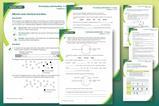… whether your students know the answer to your questions. Here’s how to ask hinge point questions and what to do next

A hinge point is a place in a lesson where there is a natural pause or slight change of topic, which can offer you a good opportunity to check, by asking certain questions, if pupils have understood what has been taught so far. The responses to these questions can guide you and your students towards what they need to do next. The hinge points can be at various points in the lesson; maybe you could use a hinge question after the initial explanation and modelling of an idea before moving on to guided written practice, or later in the lesson before tackling more extensive independent practice.
What questions should you ask?
Hinge point questions should make the pupils think more deeply; there shouldn’t be a yes or no answer. ‘Does everyone understand?’, for example, is not a helpful question, as students may answer with a yes, even if they don’t understand.
The best hinge point questions are multiple choice questions where the wrong answers are common misconceptions. It’s a good idea to encourage all pupils to respond to the hinge point questions so you get a full picture of the class. Students could use mini whiteboards or voting cards to show their answers, or you could use electronic voting with programs like Kahoot or Quizlet.
What the answers can tell you
The best-case scenario after asking a hinge question is finding out everyone understands what’s been taught so far. You can infer that you have paced the lesson correctly and move on as planned. Asking them at different stages in a lesson will illuminate what students have understood, and in subsequent lessons will tell you what they have remembered, and finally what they have mastered. The questions also act as retrieval practice to help your students cement their learning, as well as allowing you to check what they know.
What happens, however, if your hinge question shows a significant portion of the class, such as more than 30% of students, are having problems? The first step is to try and work out what the problem is. You may need to ask more questions to find out where things have gone wrong. It may be that you have gone too quickly through a concept, or not used enough scaffolding. The students might have forgotten some previous knowledge or may have latched on to a misconception. If the hinge is later in the learning process, then it could show that not enough written practice has been done.
The solution to many of these problems may be to go through the material again, more slowly, with more scaffolding, breaking the idea into more steps, or using a different analogy or model. Sometimes you have to explain why the misconception is wrong. These sorts of problems will happen less as you become more experienced at teaching the concept. The problems that come up will add to your pedagogical subject knowledge, so the next time you teach the topic you’ll know in advance what issues and misconceptions are likely to arise, and can address them early on.
Getting the right balance
If less than 20% of your students are displaying problems then you’re faced with a balancing act of supplying extra support for those few, but allowing the others to continue with the next stage of learning. Again, you have to ask yourself what the reasons for the problems are. As well as the reasons mentioned earlier, it could be that your students need longer time to process, or simply weren’t listening for a time. They may also have forgotten something they had previously understood.
One way of dealing with this smaller cohort of students with problems could be to set the majority to progress on with written practice while going through the explanation again to a small group or to just an individual. You could also ask a student who has understood the idea well to explain it to a student with problems. It should also alert you to which students might need more scaffolding and guidance when they move on to the next stage.
Teaching isn’t easy. Dealing with groups of students having different problems means there is never one simple solution, but careful use of hinge point questions can help you diagnose these problems and find routes forward.














No comments yet